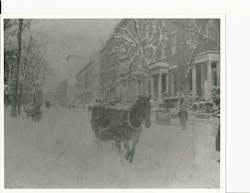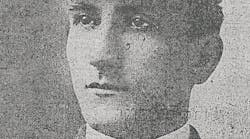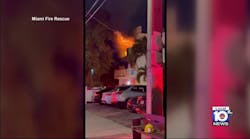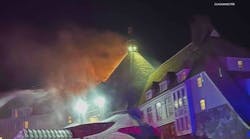BOSTON, MA: DEC. 3, 1913 – The Arcadia Lodging House was a five-story brick building with a mansard roof that housed transient men on a nightly basis. Located in the South End on Washington Street, the lodging house offered beds at nightly prices ranging from 15 to 25 cents; the higher in the building you went, the lower the price. The first floor had a saloon, shooting gallery, shoe shop and tobacco store. A fire was first seen at 2 A.M. in a first-floor closet. The staff attempted to alert the 159 men sleeping upstairs. Four minutes later, a street alarm box was transmitted. Engine 3 arrived first, stretched in and began battling the large body of fire. Meanwhile, the flames had found the large front spiral staircase and raced upward, filling the top floor. Ladders flew to the building and life nets were used to rescue many trapped above as two more hoselines were advanced up the stairs. The fire was knocked down quickly, but the damage had been done: Twenty-eight men died and 20 more were injured.
TARRYTOWN, NY: DEC. 6, 1913 – During the early-morning hours, the cries of a cat woke Mrs. Madden. The annoyed woman sat up in bed and noticed her neighbor’s home in flames. Mrs. Madden telephoned in the alarm, then dashed next door, broke into the home and rescued the husband, wife and seven children before firemen arrived.
NEW YORK CITY: DEC. 10, 1913 – Fire companies rolled into a fire in a warehouse on West 33rd Street in Manhattan. The afternoon fire, accidentally started by plumbers, filled the huge building with thick smoke. During a search, firemen came across three large cages containing six large brown bears. The bears, owned by a vaudeville performer, were being temporarily housed in the warehouse before they could be taken to an uptown theater. Firemen struggled to remove two of the heavy cages before they were driven back by the dense smoke. They dropped a tarp over the last cage before leaving the area. The flames were knocked down and the remaining bear cage was removed. All six bears were safe, but badly frightened.
HUNTINGTON, NY: DEC. 13, 1913 – Thieves looted a home on Fairview Street before setting it on fire to cover their robbery. The flames spread faster than the robbers had predicted and they were forced to flee, leaving behind all their loot. Firemen arrived quickly and extinguished the fire.
NEW YORK CITY: DEC. 17, 1913 – Flames tore through a five-story brick building at 366 Amsterdam Ave. at 4 A.M. Fire raced up the only staircase in the building and exploded out through the skylights as heavy smoke and fire filled the top floors. The officer of Engine 40 advised the chief that one of his men lived on the fourth floor. Conditions were so bad that children were being dropped from upper-floor windows and people were jumping. Three alarms were transmitted as firemen scrambled to place ladders and push hoses into the super-heated building. When the fire was knocked down and the smoke cleared, the tragic results of the blaze became clear: Three people were dead. Off-duty Fireman Thomas McManus of Engine 40 was found in his mother’s room; it was apparent he had been dragging her to safety when the heat and smoke killed them both. Mary McManus, the fireman’s sister, was also killed. Six people were seriously injured, including two firemen.
PORTSMOUTH, ENGLAND: DEC. 20, 1913 – A fire that started in a sail loft alongside the south railway jetty spread to a large wooden building and tower used to send semaphore signals to military ships. The flames continued and quickly spread to several other buildings. Naval ships sent firefighting teams ashore to help battle the conflagration. Two signalmen perished in the fire.
GULFPORT, MS: DEC. 26, 1913 – After playing a round of golf, President Woodrow Wilson spotted the roof of a large home on fire. He directed his car and another traveling with him to respond to the home. The startled woman of the house opened the door to see the President, who said, “Don’t be alarmed, but your home is on fire. But these men will put the fire out quickly if you’d show them to the attic.” The men – a naval officer, a Secret Service agent and the drivers of the automobiles – hurried inside with fire extinguishers and, under Wilson’s direction, put out the fire.







